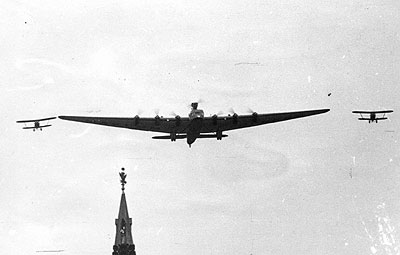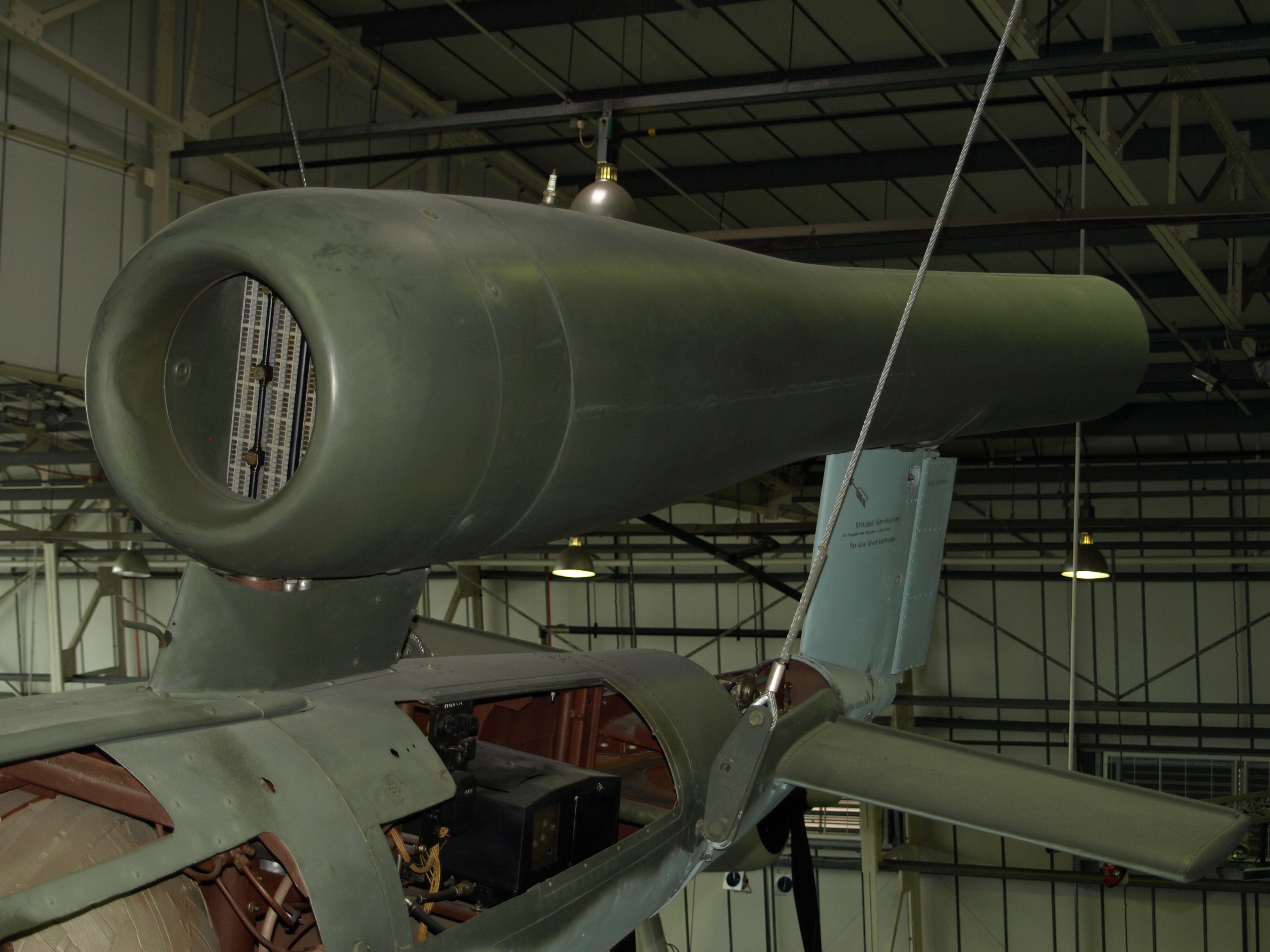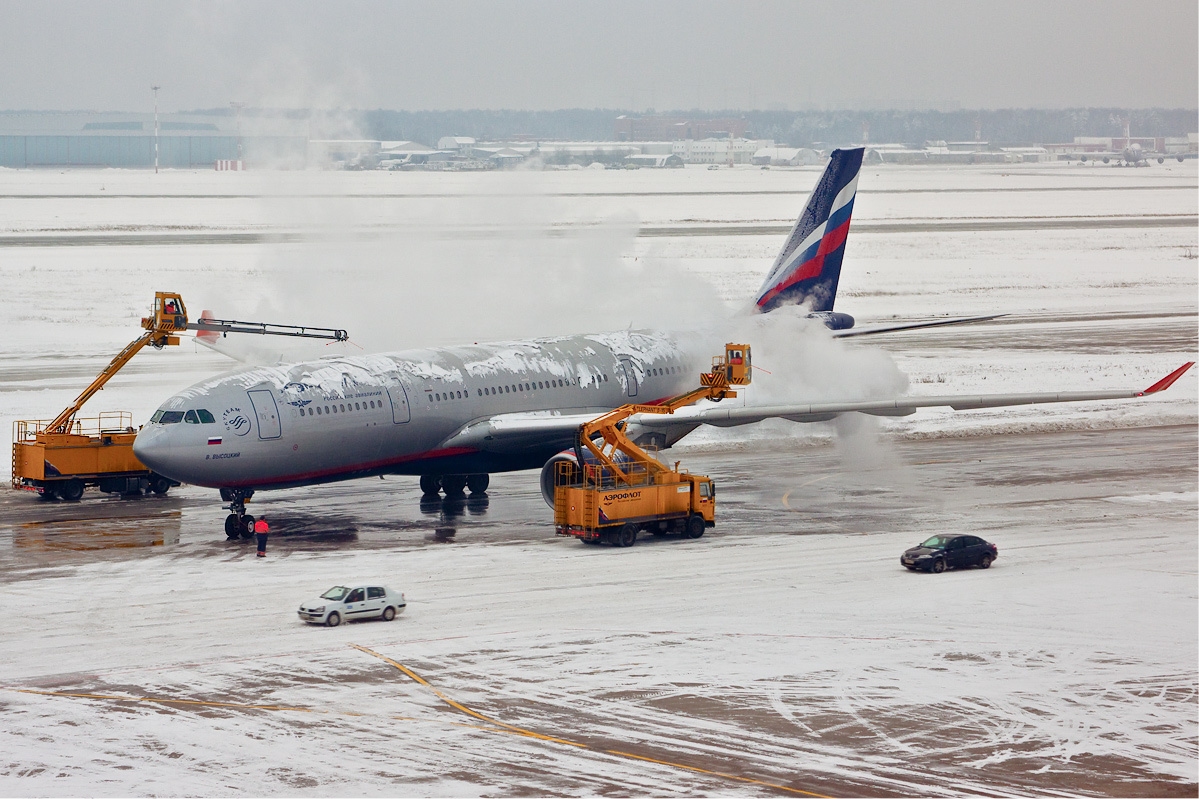|
Tupolev Tu-12
The Tupolev Tu-12 (development designation Tu-77) was an experimental Soviet jet-powered medium bomber developed from the successful piston-engined Tupolev Tu-2 bomber after the end of World War II. It was designed as a transitional aircraft to familiarize Tupolev and the VVS with the issues involved with jet-engined bombers. Development The Tupolev Tu-73 jet-engined bomber project was suffering delays in early 1947 and Tupolev suggested re-engining the Tu-2 medium bomber with imported British Rolls-Royce Nene jet engines to produce a jet bomber as quickly as possible. Design work began well before official approval was received on 31 May 1947 for one Tu-2S to be converted in the OKB's workshop and another five to be converted at Zavod (Factory) Nr. 23, but construction of the prototype had already begun in early May under the bureau designation Tu-77. Changes from the standard Tu-2 were minimized to speed production and they consisted of the following:Gordon & Rigamant, p. 118 ... [...More Info...] [...Related Items...] OR: [Wikipedia] [Google] [Baidu] |
Tupolev Tu-12 Starboard Front
Tupolev (russian: Ту́полев, ), officially Joint Stock Company Tupolev, is a Russian aerospace and defence company headquartered in Basmanny District, Moscow. Tupolev is successor to the Soviet Tupolev Design Bureau (OKB-156, design office prefix ''Tu'') founded in 1922 by aerospace pioneer and engineer Andrei Tupolev, who led the company for 50 years until his death in 1972. Tupolev has designed over 100 models of civilian and military aircraft and produced more than 18,000 aircraft for Russia, the Soviet Union and the Eastern Bloc since its founding, and celebrated its 90th anniversary on 22 October 2012. Tupolev is involved in numerous aerospace and defence sectors including development, manufacturing, and overhaul for both civil and military aerospace products such as aircraft and weapons systems, and also missile and naval aviation technologies. In 2006, Tupolev became a division of the United Aircraft Corporation in a merger with Mikoyan, Ilyushin, Irkut, Sukhoi, a ... [...More Info...] [...Related Items...] OR: [Wikipedia] [Google] [Baidu] |
Trim Tab
Trim tabs are small surfaces connected to the trailing edge of a larger control surface on a boat or aircraft, used to control the trim of the controls, i.e. to counteract hydro- or aerodynamic forces and stabilise the boat or aircraft in a particular desired attitude without the need for the operator to constantly apply a control force. This is done by adjusting the angle of the tab relative to the larger surface. Changing the setting of a trim tab adjusts the neutral or resting position of a control surface (such as an elevator or rudder). As the desired position of a control surface changes (corresponding mainly to different speeds), an adjustable trim tab will allow the operator to reduce the manual force required to maintain that position—to zero, if used correctly. Thus the trim tab acts as a servo tab. Because the center of pressure of the trim tab is farther away from the axis of rotation of the control surface than the center of pressure of the control surface, the ... [...More Info...] [...Related Items...] OR: [Wikipedia] [Google] [Baidu] |
Tupolev Aircraft
Tupolev (russian: Ту́полев, ), officially Joint Stock Company Tupolev, is a Russian aerospace and defence company headquartered in Basmanny District, Moscow. Tupolev is successor to the Soviet Tupolev Design Bureau (OKB-156, design office prefix ''Tu'') founded in 1922 by aerospace pioneer and engineer Andrei Tupolev, who led the company for 50 years until his death in 1972. Tupolev has designed over 100 models of civilian and military aircraft and produced more than 18,000 aircraft for Russia, the Soviet Union and the Eastern Bloc since its founding, and celebrated its 90th anniversary on 22 October 2012. Tupolev is involved in numerous aerospace and defence sectors including development, manufacturing, and overhaul for both civil and military aerospace products such as aircraft and weapons systems, and also missile and naval aviation technologies. In 2006, Tupolev became a division of the United Aircraft Corporation in a merger with Mikoyan, Ilyushin, Irkut, Sukhoi, ... [...More Info...] [...Related Items...] OR: [Wikipedia] [Google] [Baidu] |
1940s Soviet Bomber Aircraft
Year 194 ( CXCIV) was a common year starting on Tuesday (link will display the full calendar) of the Julian calendar. At the time, it was known as the Year of the Consulship of Septimius and Septimius (or, less frequently, year 947 ''Ab urbe condita''). The denomination 194 for this year has been used since the early medieval period, when the Anno Domini calendar era became the prevalent method in Europe for naming years. Events By place Roman Empire * Emperor Septimius Severus and Decimus Clodius Septimius Albinus Caesar become Roman Consuls. * Battle of Issus: Septimius Severus marches with his army (12 legions) to Cilicia, and defeats Pescennius Niger, Roman governor of Syria. Pescennius retreats to Antioch, and is executed by Severus' troops. * Septimius Severus besieges Byzantium (194–196); the city walls suffer extensive damage. Asia * Battle of Yan Province: Warlords Cao Cao and Lü Bu fight for control over Yan Province; the battle lasts for over 100 days ... [...More Info...] [...Related Items...] OR: [Wikipedia] [Google] [Baidu] |
Berezin UB
The Berezin UB (russian: УБ - Универсальный Березина) (''Berezin's Universal'') was a 12.7 mm caliber Soviet aircraft machine gun widely used during World War II. Development In 1937, Mikhail Yevgenyevich Berezin began designing a new large-caliber aircraft machine gun chambered to the 12.7 mm round used by infantry machine guns. The new design passed factory trials in 1938 and was accepted into service in 1939 under the designation BS (Березин Синхронный, Berezin Sinkhronniy, Berezin Synchronized). The rate of fire made it well suited for use as defensive armament in aircraft. While a successful design, BS was not without its faults, the biggest being its cable-operated charging which required considerable physical strength. Continued development resulted in the improved UB which came in three versions: UBK (Крыльевой, Krylyevoi, for the wings), UBS (Синхронный, Sinkhronniy, Synchronized), and UBT (Турель ... [...More Info...] [...Related Items...] OR: [Wikipedia] [Google] [Baidu] |
Pulse Jet Engine
300px, Diagram of a pulsejet A pulsejet engine (or pulse jet) is a type of jet engine in which combustion occurs in pulses. A pulsejet engine can be made with few or no moving parts, and is capable of running statically (i.e. it does not need to have air forced into its inlet, typically by forward motion). The best known example may be the Argus As 109-014 used to propel Nazi Germany's V-1 flying bomb. Pulsejet engines are a lightweight form of jet propulsion, but usually have a poor compression ratio, and hence give a low specific impulse. There are two main types of pulsejet engines, both of which use resonant combustion and harness the expanding combustion products to form a pulsating exhaust jet that produces thrust intermittently. The first is known as a valved or traditional pulsejet and it has a set of one-way valves through which the incoming air passes. When the air-fuel is ignited, these valves slam shut, which means that the hot gases can only leave through the engin ... [...More Info...] [...Related Items...] OR: [Wikipedia] [Google] [Baidu] |
Yakovlev Yak-23
The Yakovlev Yak-23 (russian: Яковлев Як-23; USAF/DoD reporting name Type 28, NATO reporting name Flora) was an early Soviet jet fighter with a straight wing. It was developed from the Yak-17 in the late 1940s and used a reverse-engineered copy of a British engine. It was not built in large numbers as it was inferior in performance to the swept-wing Mikoyan-Gurevich MiG-15. Many Yak-23s were exported to the Warsaw Pact nations and remained in service for most of the 1950s, although some were still in use a decade later. Development and description On 11 March 1947, the Council of People's Commissars ordered several design bureaux (OKB), including that of Alexander Yakovlev, to develop a single-seat, straight-winged jet fighter to be equipped with a single British Rolls-Royce Nene or Rolls-Royce Derwent turbojet engine. The aircraft should have a maximum speed of at sea level and a speed of at an altitude of . It should be able to climb to that altitude in 3.5 minutes ... [...More Info...] [...Related Items...] OR: [Wikipedia] [Google] [Baidu] |
Mikoyan-Gurevich MiG-9
The Mikoyan-Gurevich MiG-9 (russian: Микоян и Гуревич МиГ-9, USAF/DoD designation: Type 1, NATO reporting name: Fargo) was the first turbojet fighter developed by Mikoyan-Gurevich in the years immediately after World War II. It used reverse-engineered German BMW 003 engines. Categorized as a first-generation jet fighter, it suffered from persistent problems with engine flameouts when firing its guns at high altitudes due to gun gas ingestion. A number of different armament configurations were tested, but none solved the problem. Several different engines were evaluated, but none were flown as the prototype of the MiG-15 promised superior performance. A total of 610 aircraft were built, including prototypes, and they entered service in 1948 with the Soviet Air Forces. At least 372 were transferred to the People's Liberation Army Air Force in 1950 to defend Chinese cities against air raids by the Nationalist Chinese and train the Chinese pilots in jet op ... [...More Info...] [...Related Items...] OR: [Wikipedia] [Google] [Baidu] |
Identification Friend Or Foe
Identification, friend or foe (IFF) is an identification system designed for command and control. It uses a transponder that listens for an ''interrogation'' signal and then sends a ''response'' that identifies the broadcaster. IFF systems usually use radar frequencies, but other electromagnetic frequencies, radio or infrared, may be used. It enables military and civilian air traffic control interrogation systems to identify aircraft, vehicles or forces as friendly and to determine their bearing and range from the interrogator. IFF is used by both military and civilian aircraft. IFF was first developed during World War II, with the arrival of radar, and several friendly fire incidents. IFF can only positively identify friendly aircraft or other forces. If an IFF interrogation receives no reply or an invalid reply, the object is not positively identified as foe; friendly forces may not properly reply to IFF for various reasons such as equipment malfunction, and parties in the area ... [...More Info...] [...Related Items...] OR: [Wikipedia] [Google] [Baidu] |
Deicing
Deicing is the process of removing snow, ice or frost from a surface. Anti-icing is the application of chemicals that not only deice but also remain on a surface and continue to delay the reformation of ice for a certain period of time, or prevent adhesion of ice to make mechanical removal easier. Deicing can be accomplished by mechanical methods (scraping, pushing); through the application of heat; by use of dry or liquid chemicals designed to lower the freezing point of water (various salts or brines, alcohols, glycols); or by a combination of these different techniques. Application areas Roadways In 2013, an estimated 14 million tons of salt were used for deicing roads in North America. Deicing of roads has traditionally been done with salt, spread by snowplows or dump trucks designed to spread it, often mixed with sand and gravel, on slick roads. Sodium chloride (rock salt) is normally used, as it is inexpensive and readily available in large quantities. However, since ... [...More Info...] [...Related Items...] OR: [Wikipedia] [Google] [Baidu] |
Tushino Aviation Day Parade
In the life of Soviet Union, air shows were a highly regarded type of parade, almost always of military nature. They happened on various occasions and anniversaries, in many locations across the country. A notable air show was the Tushino Air Show held annually in August. Dates Soviet Air Fleet Day The most frequent date of air shows was the Soviet Air Fleet Day (russian: День Воздушного Флота). It was also known as the Soviet Air Forces Day (russian: День Военно-воздушных Сил), or Soviet Aviation Day.Pre-history of MAKS - provides the complete information on Russian and Soviet air shows. It was established in 1933 and was most usually held on the third Sunday of August, weather permitting. The initial exhibition on 18 August 1933, was a result of |
Nudelman-Suranov NS-23
The NS-23 was a aircraft cannon designed by A. E. Nudelman, A. Suranov, G. Zhirnykh, V. Nemenov, S. Lunin, and M. Bundin during World War II as a replacement for the Volkov-Yartsev VYa-23 cannon. It entered service in 1944. The NS-23 round was derived from the 14.5×114mm anti-tank round by necking it out to 23 mm. A synchronized version, designated NS-23S (for ''synchronized''), was used for fixed installations firing through the propeller arc. Applications of the NS-23 included the Antonov An-2, Ilyushin Il-10, Ilyushin Il-22, Lavochkin La-9, La-15, MiG-9, Yak-9UT, Yak-15, Yak-17, Yak-23, and Tu-4. Some early MiG-15s were also equipped with the NS-23. The NS-23 was replaced in service by the Nudelman-Rikhter NR-23 The Nudelman-Richter NR-23 is a Soviet autocannon widely used in military aircraft of the Soviet Union and Warsaw Pact. It was designed by A. E. Nudelman and A. A. Richter to replace the wartime Nudelman-Suranov NS-23 and Volkov-Yartsev VYa-23, ... aroun ... [...More Info...] [...Related Items...] OR: [Wikipedia] [Google] [Baidu] |







.jpg)

